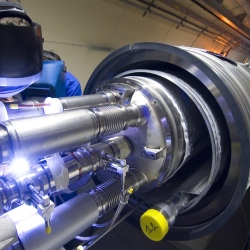
When Europe’s Large Hadron Collider (LHC) started up in 2008, particle physicists would not have dreamt of asking for something bigger until they got their US$5-billion machine to work.
But with the 2012 discovery of the Higgs boson, the LHC has fulfilled its original promise — and physicists are beginning to get excited about designing a machine that might one day succeed it: the Very Large Hadron Collider (VLHC).
“It’s only prudent to try to sketch a vision decades into the future,” says Michael Peskin, a theoretical physicist at SLAC National Accelerator Laboratory in Menlo Park, California, who presented the VLHC concept to a US government advisory panel on 2 November.
The giant machine would dwarf all of its predecessors (see ‘Lord of the rings’). It would collide protons at energies around 100 teraelectronvolts (TeV), compared with the planned 14 TeV of the LHC at CERN, Europe’s particle-physics lab near Geneva in Switzerland. And it would require a tunnel 80–100 kilometres around, compared with the LHC’s 27-km circumference. For the past decade or so, there has been little research money available worldwide to develop the concept. But this summer, at the Snowmass meeting in Minneapolis, Minnesota — where hundreds of particle physicists assembled to dream up machines for their field’s long-term future — the VLHC concept stood out as a favourite.
Some physicists caution that the VLHC would be only a small part of the global particle-physics agenda. Other priorities include: upgrading the LHC, which shut down in February for two years to boost its energies from 7 TeV to 14 TeV; plans to build an International Linear Collider in Japan, to collide beams of electrons and positrons as a complement to the LHC’s proton findings; and a major US project to exploit high-intensity neutrino beams generated at the Fermi National Accelerator Laboratory in Batavia, Illinois. Jonathan Rosner, a particle physicist at the University of Chicago, Illinois, who convened Snowmass, says that these forthcoming projects should be the focus. “It’s premature to highlight the VLHC,” he says.
